Granary Burying Ground
Introduction
Text-to-speech Audio
Images
Granary Burying Ground (image from Wikimedia)
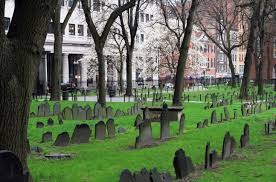
Granary Burying Ground (image from Historic Markers Database)
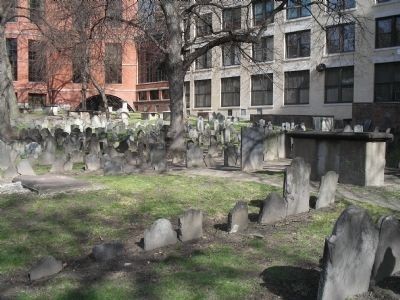
Examples of gravestone carvings (image from Wikimedia)
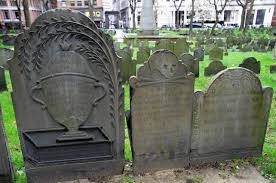
Depiction of the entrance to the Granary, 1881, with European elms which are no longer present (image from Wikimedia)
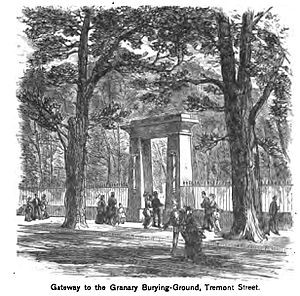
Franklin Family Obelisk (image from Historic Markers Database)
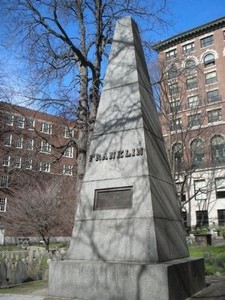
Grave of John Hancock (image from Historic Markers Database)
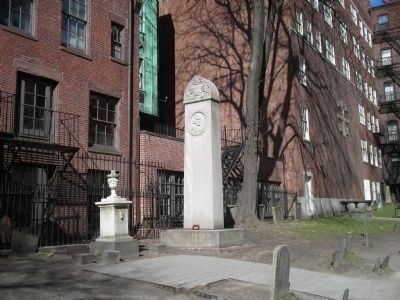
Grave of Paul Revere (image from Historic Markers Database)
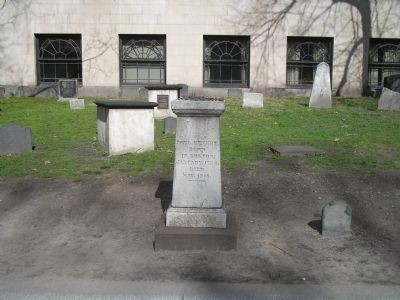
Paul Revere marker (image from Historic Markers Database)
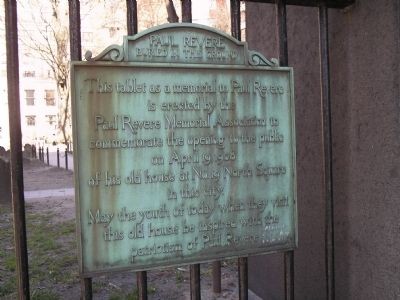
James Otis marker (image from Historic Markers Database)
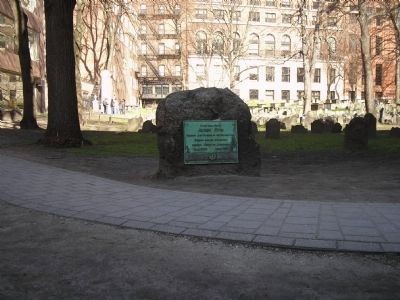
Victims of the Boston Massacre marker (left) and the grave of Samuel Adams (right) (image from Historic Markers Database)
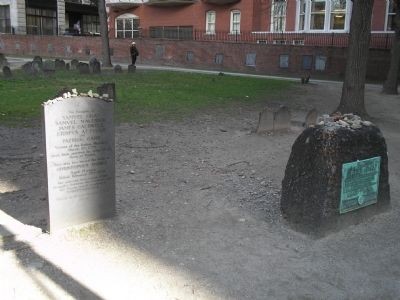
Map of historic markers and signage in the Granary Burying Grounds (map from Historic Markers Database)
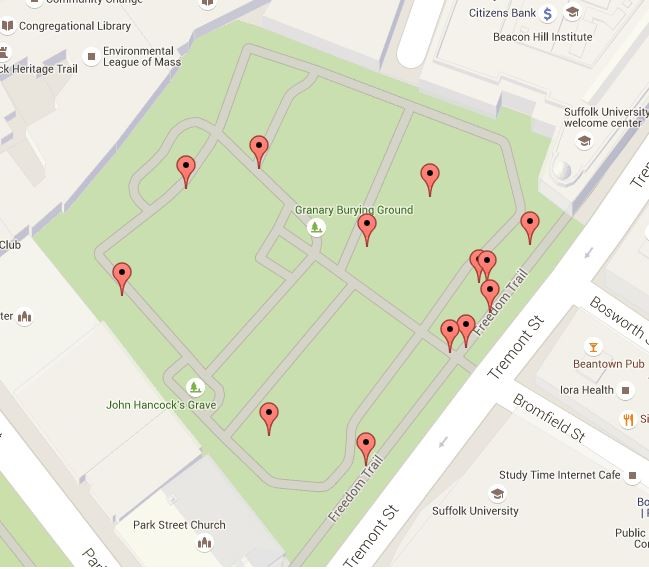

Backstory and Context
Text-to-speech Audio
Originally part of Boston Common, the Granary Burying Ground was established in 1660 when nearby King's Chapel Burying Ground became overcrowded. The livestock of the Common were initially used to control the growth of weeds and grass in the burying ground. It earned its name in 1737, when a small granary was built across the street, where Park Street Church sits today. Though there are 2,345 gravestones and tombs, the grounds are estimated to hold 5,000 burials. Many of the headstones no longer correspond to grave sites, as the rows were straightened during nineteenth century landscaping. Among the notable burials are Samuel Adams, John Hancock, Robert Treat Paine, Peter Faneuil, Paul Revere, James Otis, Benjamin Franklin's parents, five victims of the Boston Massacre, and many Massachusetts governors, mayors, and clergymen. The last interment at the Granary took place in 1880.
Historic Marker Inscriptions:
Granary Burying Ground
1660
Within this ground are buried
John Hancock, Samuel Adams
and Robert Treat Paine,
signers of the Declaration of Independence;
Governors
Richard Bellingham, William Dummer,
James Bowdoin, Increase Sumner,
James Sullivan and Christopher Gore;
Lieut. Governor Thomas Cushing;
Chief Justice Samuel Sewall;
Ministers John Baily, Samuel Willard,
Jeremy Belknap and John Lathrop.
Welcome to Granary Burying Ground
Welcome to Granary Burying Ground, one of the oldest historic sites in Boston! Famous, infamous, and unknown Bostonians are buried here. Men, women, children, Puritans, Anglicans, Catholics, English, French, Africans, patriots, Tories, printers, goldsmiths, merchants, and scavengers were all laid to rest in Granary. Seventeenth-century Puritans John Endecott (Sign #5) and Samuel Sewall (Sign #6) rest here, as do revolutionaries Samuel Adams (Sign #2), John Hancock (Sign #7), James Otis (Sign #8), Paul Revere, and the victims of the Boston Massacre (Sign #2). Women such as Abiah Franklin (Sign #4), Mary (not Mother) Goose (Sign #5), and Ruth Carter (Sign #3) are memorialized in stone. There are tragic tales of duels (Sign #8) and slave trading (Signs #6 and #7). In Granary rest nine Massachusetts governors, three signers of the Declaration of Independence, and many Revolutionary War veterans.
This graveyard was started by Boston’s town officials in 1660 because of overcrowding at the “old burying ground” (King’s Chapel, one block away). Granary is Boston’s third graveyard and was referred to as the “New Burying Ground” or “South Burying Ground.” Later it was called “Middle” or “Central” Burying Ground until it was named “Granary” after 1800. This name referred to the 12,000-bushel grain storage warehouse built in 1729 to provide food for the poor. The Granary building was moved to Dorchester in 1809 to make way for Park Street Church. It was originally a part of the Common at the very edge of 17th century Boston where the land rose steeply to three towering hills or “trimountain.” Here, Boston Town put “noxious” buildings and activities they wanted away from the bustling harbor businesses, including the burying grounds, the almshouse or poorhouse, the prison, the cow pen, and the workhouse.
The Granary Burying Ground today covers approximately two acres and contains 2,345 gravestones and 204 tombs. It is probable that more than 8,000 men, women, and children were buried here, the majority in the tombs that border the grounds. Many gravestones have decayed or have been lost. Granary was overcrowded by the 18th century, and burials outside of tombs were prohibited from 1856 on. The gravestone locations have been rearranged at least two times to accommodate pathways and landscaping, so many no longer mark the actual burial location. In 1840 Solomon Willard, sculptor and architect of the Bunker Hill Monument, designed Granary’s Egyptian-style gateway.
First Mayor and First Architect
The Honorable John Phillips (1770-1823) united warring town factions to form a city government and become Boston’s first mayor in 1822. His son, Wendell Phillips, was the famous abolitionist. Mayor Phillips was buried in Tomb 60, the Buttoph Family tomb.
Scottish architect and portrait painter John Smibert (1688-1751) painted many of the wealthy Bostonians who are buried in Granary Burying Ground. Smibert immigrated to Boston in 1729 and married Mary Williams (1708-after 1753), daughter of schoolmaster Nathaniel Williams. In his first five years in Boston he produced more than 100 portraits of Bostonians, including Judge Samuel Sewall. He later painted Peter Faneuil (sign #7) and was the architect for the original Faneuil Hall in 1740-42. He is recognized today as America’s first architect. When he died in 1751 he was buried in the Nathaniel Williams Tomb (62). Tomb 62’s tablet is inscribed “Thomas and John Bradlee’s Tomb 1816,” with no markings for its 18th century residents. In the 19th century this tomb, similar to many others in Granary, was resold after the colonial owners died out or left town with the British.
Seventeenth Century BurialsAround you are some of the earliest burials at Granary
Burial Ground. “The Oldest Stone” dated 1667 marked the burial of John Wakefield (ca. 1615-1667).
Apparently a frugal relative 36 years later had the back of the stone carved
for Ann Child (c. 1623-1703),
whose daughter married a Wakefield. The nearby stone carries both names.
The Neal Children: The “Oldest Date on a Gravestone” (1666) is that on the marker of four of the children of Andrew (ca. 1624 – 1684) and Melicent Neal
(d. 1687): Andrew (d. 1672 aged 18 months), Elizabeth (d. 1666 aged 3 days),
Elizabeth (d. 1671 aged 2 weeks), and Hannah (n.d.). It was not unusual for colonial parents to name a
new child after one that had died. Andrew Neal was the innkeeper of the Starr
Inn.
The James/Allen/Ebenezer Wells Tomb has the “oldest date on a tomb” of 1667. James Allen (1632-1710), minister of
the First Church, was “very humble and very rich.” He built this tomb and
buried his first wife, Hannah (Drummer),
here in 1667 when she was 21 years old and his second wife, Elizabeth (Houchin) Endicott (ca. 1638-1673),
when she was 35 years old. It is probable that the third Mrs. Allen, Sarah (Hawkins) Breck (1638-1710), was
buried here as well.
The Myth of Boston’s Mother Goose
Nestled together near a tree are the gravestones of three generations of the Goose/Vergoose family, Mary (Balstin) Goose (ca. 1648-1690) gave birth to at least 10 children with her husband, Isaac Goose (also known as Vergoose) (d. 1710), a carter and scavenger. After Mary Goose’s death Isaac married Elizabeth (Foster) of Charleston, who bore him five children. Their daughter, Elizabeth (Goose), married Thomas Fleet (c. 1685-1758), publisher of the Boston Evening Post, whose printing shop was at The Sign of the Heart and Crown. In the 19th century a story circulated that Thomas Fleet was the first publisher of Mother Goose stories and these tales were told by his mother-in-law. No copy of Mother Goose tales published by Thomas Fleet has been found. Though Thomas Fleet is buried near Mary Goose, there is no record that Elizabeth Vergoose, his mother-in-law, is buried at Granary.
The Freake Tomb
The Tomb of Elizabeth and John Freake, showing their coat-of-arms, is another early tomb marked with a slab set in the ground. John and Elizabeth (Clarke) married before 1662 and Elizabeth bore eight children, including Mary, shown with her in the portrait. John was killed in an explosion on a boat in 1675. Elizabeth remarried to Elisha Hutchinson in 1677 and bore another six children, while raising the surviving children from both of their marriages. Elizabeth died in 1713 at the age of 71 and joined John in their tomb. Elisha Hutchinson died in 1717 and was buried with his wife and her first husband.
Governors, Merchants, and Slave Traders
Five of the nine Massachusetts governors buried in Granary are in this section of the grounds including, William Drummer (1677-1761), Tomb 168; John Endecott (1589-1665), Tomb 189; and Increase Summer (1746-1799), Tomb 180. Governors Richard Bellingham (1592-1672) and James Sullivan (1744-1808) are both buried in Tomb 146. Bellingham was infamous for secretly conducting his own marriage ceremony in 1641 to his second wife, Penelope Pelham.
Massachusetts’ colonial economy depended on the Atlantic trade between Britain, the West Indies, Africa, and the American colonies. In 1687 one visitor observed that most houses in Boston had one or two slaves. Brought to Boston by 1638, African slaves were an important commodity in the West Indies trade of Boston merchants. Most of the colonial governors owned slaves, while prominent merchants such as Hugh Hall (1693-1773), Tomb 144, and David S. Greenough (1752-1826), Tomb 170, imported and sold slaves and owned plantations in the West Indies.
Gravestone Carving
In early Boston when someone died, their family or friends indicated their burial site with a marker for remembrance. Often the deceased had already ordered their gravestone before their death. Gravestones were carved by masons, stonecutters, painters, and other craftsmen with artistic skills. As you walk through the burying ground you can see particular styles that indicate the same carver at work. Only a few carvers signed their work with their initials.
The first and cheapest grave markers were made of wood, which did not survive in the damp seaside climate of New England. In the 17th century, early stone markers had simply initials and dates. The gravestone of Thomas Plats (d. 1685), a Boston butcher, is made of red stone and has only letters and numbers, no carved symbols. Soon carvers started engraving symbols and messages on the stones:
“Death’s head,” a non-religious symbol, is a skull often with wings and/or crossed bones. It is the earliest symbol employed in this graveyard. Other decorative motifs accompanying the death’s head were the hourglass (and even a winged hourglass – symbolizing the concept “time flies”), coffins, elaborately carved side panels with florets, finials, foliage, fruit, and imaginary figures. The majority of gravestone carvings in Granary is death’s heads. See the nearby gravestones of Hugh Mackgill (d. 1724) and Paul Revere’s first wife, Sarah (Orne) Revere (d.1773). Ruth (Wiswall) Mountfort Carter’s (1656-1698) is more elaborate, with two standing skeletons carved around its epitaph.
“Winged cherub” or a soul effigy, is characterized by a fleshy face, life-like eyes, and an upwards-turned mouth. Cherubs started appearing in the late 17th century and are common in the 18th century. The gravestones of David Gleason (d. 1768), an infant, and Mary Devens (d. 1778) have winged cherubs.
The “willow and urn” symbols are seen most often after the American Revolution. The willow was an ancient mourning symbol. The urn was an Imperial Roman device used to contain ashes. Usage of these motifs was part of a larger trend toward sentimentality in mourning art. There are very few “willow and urn” motifs at this burying ground. Look for the gravestone of William Claghorn (Sign #8).
Some bereaved relatives commissioned special symbols for gravestones. Lt. Jabez Smith, Jr. (1751-1780) was a young lieutenant of the Marines aboard the Continental ship Trumbull. A replica of the ship is carved into his stone. Other families chose to display a coat of arms, including Peter Faneuil (Sign #7) and Robert and Elizabeth Freake (Sign #5). Prominent politicians and officials are memorialized by monuments such as obelisks, including Benjamin Franklin’s family (Sign #4), John Hancock (Sign #7), and Increase Sumner (Sign #5).
Early English Arrivals
When Jacob Eliot (1632-1693), yeoman and deacon of South Church died, Samuel Sewall wrote: “Tis a sudden and sore blow to the South Church, a loss hardly repaired . . . . He was one of the most serviceable men in Boston . . . . one of the first that was born in Boston.” Eliot’s gravestone is surrounded by those of his wife and children.
Bartholomew Green (1666-1732) was the son of printer Samuel Green, who arrived in 1630. In 1704 Bartholomew started to print the Boston Newsletter, the first American newspaper. The paper remained with the family through his daughter, Deborah (Green) Draper, and grandson, Richard Draper (Sign #4).
The Fighting Armstrongs
Tomb 192 holds the remains of the Armstrong family. In 1776 the patriarch, Colonel John Armstrong (d. 1776), marched to Long Island with his two sons, Captain John Armstrong and Major Samuel Armstrong (1754-1810), where their troops engaged the British Army. Colonel Armstrong was killed on the battle field while his sons were wounded and barely escaped. His grandson, Samuel Turrell Armstrong (1784-1850), was a publisher, banker, and statesman who held a number of political offices, including mayor and acting governor. The inscription was placed by descendant Lieutenant George Washington Armstrong (1792-1866), who served in the War of 1812.
Colonial Craftsmen
Until a few decades before the American Revolution, Boston was the largest port in the British colonies. It thrived on maritime trade, shipbuilding, and the work of hundreds of craftspeople. While the tombs of the rich merchants and politicians ring the burial ground, the majority of the gravestones belong to the skilled and unskilled workers of colonial Boston and their families.
Nathaniel Hurd (1730-1777) and Benjamin Hurd (1739-1781) were engravers, silversmiths, and goldsmiths. Nathaniel designed the seal of Harvard College and, like Paul Revere, he was painted by John Singleton Copley in his working clothes.
Paul Revere (1734-1818) was also a master engraver, silversmith, and goldsmith who lived in Boston’s North End. But he is most famous as one of the patriots who made the “midnight ride” to warn John Hancock and Sam Adams of the British march to Concord on April 18, 1775. Revere was an active “Son of Liberty,” helped plan the Boston Tea Party, and participated in the Revolutionary War. Later he became an industrialist, whose copper foundry and rolling mill made brass fittings for the U. S. S. Constitution and the Massachusetts State House’s original dome. He and his second wife, Rachel (Walker) (1745-1813), are buried in tomb 127. His first wife, Sarah (Orne) Revere, and his father, Paul Revere, are buried near Sign #3.
Samuel Gore (1751-1831) was a painter, japanner, and printer, who participated in the Boston Tea Party. He and his brother Governor Christopher Gore (1758-1829), are buried in the Gore family tomb (123). Other Boston Tea Party participants buried in this section of Granary are retailer Henry Bass (1739-1842), Tomb 178; hatter Joseph Eaton (1750-1825), Tomb 200; Joseph Lee (1744-1831), Tomb 125; and William Pierce (1744-1840), Tomb 173.
John Hull (1624-1683), silversmith, goldsmith, and the colony’s mint master and treasurer, was one of the leading craftsmen of Boston in the 17th century. With his partner, Robert Sanderson (d. 1693), he produced the “pine-tree” shilling and other colonial coinage. He also created silver and gold tableware for his customers.
John Hull’s only daughter, Hannah (1658-1717), married Judge Samuel Sewall (1652-1730) and bore him 14 children. Only seven children survived to adulthood and all are buried here. Seawall is probably best known as one of the judges at the Salem Witchcraft trials. In 1696 he publicly asked forgiveness for his condemnation of those innocent people. In 1700 he published The Selling of Joseph, an anti-slavery treatise. Upwards of 40 Hull-Quincy-Sewall family members were buried in Tomb 185 over two centuries.
Also buried nearby is Abiah Holbrook (1718-1769), master of the South Writing School on West Street from 1742-1769. He taught John Hancock his penmanship.
John Foster Williams (1743-1814) was a patriot privateer and naval officer who fought many battles and was captured by the British in 1781. He was the captain of the revenue cutter Massachusetts for 24 years.
African and African American Burials
In colonial Boston the free Black community resided in
Boston’s North End and most often chose Boston’s second burying ground, Copp’s
Hill, for burial. The rates for burials in 1732 were as follows:
For white man or woman….. – 10 shillings
For persons 6 to 12 years of age….. – 7 shillings
For children caryed by hand….. – 6 shillings
For negro man or woman….. -7 shillings & 6 pence
Ditto from 6 to 12 years of age….. – 6 shillings
For children….. – 4 shillings
For opening the new or wall Toombes….. – 14 shillings
For opening an old Tomb….. – 16 shillings
Some Africans who lived in the area around Granary Burying Ground had been slaves and were buried in the tombs of their masters. Cloe Spear (d. 1815) was an African woman who was captured and sold into slavery at a young age. Although freed after the Revolution, she is buried in the tomb (199) of her owner, Capt. John Bradford (d. 1784). Her autobiography entitled Memoir of Mrs. Chloe Spear, a Native of Africa, Who was Enslaved in Childhood, and Died in Boston, January 3, 1815, Aged 65 Years was published in Boston in 1832 and is a rare northern slave narrative.
Tragic Events
Three hundred years ago this location did not have ideal conditions for a graveyard. There were many underground springs which made it soggy and damp. Tomb owners routinely found their tombs filled with water, with caskets and bodies floating about. Since the grass grew quickly, the Boston selectmen, always looking to turn a profit, rented the Granary Burying Ground as pasture to gravedigger James Williams (d. 1734), with the proviso that the renter make good all damages “which may happen to the graves by reason of his Cows going there.” By 1740 gravediggers complained that the burial ground was “so filled with Dead Bodies, they are obligated oft times to bury them four deep . . . . ” In 1795, a panel of physicians warned of the health dangers from the “crowded state of these grounds and the exhalations which must frequently arise from the opening of graves” as well as it “being almost impossible to dig new graves without disturbing the relics of the dead already interred.”
On the evening of July 3, 1728, young Harvard graduate Benjamin Woodbridge (ca. 1708-1728), age 20, and Henry Phillips, age 22, quarreled at the Royal Exchange tavern. A challenge was given and they adjourned to Boston Common for a duel. Woodbridge was stabbed by Phillips and died the next day. Henry Phillip’s father was Boston’s leading bookseller and part of the French Huguenot community, so Henry fled to France where he died of grief within a year. Woodbridge was buried at Granary at the request of his father, Magistrate Dudley Woodbridge of Groton and Barbados.
James Otis (1725-1783), lawyer, politician, and writer, graduated from Harvard in 1743. Otis was an eloquent author and orator for the patriot cause, who John Adams described as “a flame of fire.” He vigorously argued against the British Writs of Assistance, acts that allowed customs officials to enter private property to search for contraband. Otis was Boston’s most brilliant attorney and he served in the Massachusetts General Court until 1771. In 1769, British official John Robinson hit Otis in the head during a tavern brawl, which led to the end of Otis’ career. “I hope when God shall take me out of time into eternity, that it will be by a flash of lightening,” Otis wrote his sister, historian Mercy Otis Warren. As he wished, Otis died in Andover, Massachusetts, in 1783, after being struck by lightening during a thunderstorm. James Otis is buried with his wife, Ruth (Cunningham), an alleged Tory, in her family’s tomb (Tomb 40).
Dr. David Townshed (d.1829) was a volunteer surgeon at the Battle of Bunker Hill. He became the surgeon general of the Sixth Continental army in the American Revolution, serving from 1775-1783. He and his wife, Elizabeth (d.1833), are buried in Tomb 55.
Rev. Jeremy Belknap (1744-1798) was born in Boston and graduated from Harvard College. He served as a minister in Dover, New Hampshire, until moving to the Federal Street Church in Boston in 1787. A published historian, Belknap’s greatest contribution was as the catalyst for the founding of the first repository of America’s history, the Massachusetts Historical Society, in 1791. He was also an early and ardent abolitionist and a benefactor of the Massachusetts General Hospital. He was buried in Tomb 33, but his granddaughter moved his remains to Mount Auburn Cemetery in 1837.
Tomb 21 is the burial place of two colonial schoolmasters,
John Tileston (1735-1826) and Rufus Webb (1768-1827). Tileston was the
headmaster of the North Writing School for 57 years. Webb was the master of the
South Writing School for many years.
Esther (Martin) Lovering (ca. 1772-1798) married Joseph Lovering, Jr., a tallow chandler of Roxbury, and died at the age of 26.
Samuel Black (d. 1750) was a successful merchant. Unmarried, his will directed his executors to “free my negro boy Leicester and give him 400 (pounds?) at the expiration of his term of apprentice-ship” and to sell all his real estate “as my brothers and sisters are in Ireland.”
Captain William Claghorn (ca. 1733-1793) was a prosperous New Bedford shipowner and merchant who died unexpectedly in Boston. His epitaph reads:
To the memory of / CAPT. WILL’M CLAGHORN / Who died in a fit of the Apoplexy / On a visit to this Town / Feb’y Ye 24th 1793, / In the 60th Year of his Age. / Here lies entomb’d, beneath / the turfed Clod, / A Man belov’d, the noblest work of God; / With friendly throbs, thine heart / beats no more, / Clos’d the gay Scene, the Pomp / of Life is o’er.
A Riot, the Massacre, and the Tea Party
From 1769-1776 Boston was the flashpoint for events leading
up to the American Revolution. On February 22, 1770, a crowd gathered around
the house and shop of a Tory sympathizer and customs agent, Ebenezer
Richardson. When they started pelting the house with snowballs and debris,
Richardson shot his gun into the crowd, hitting 12-year-old Christopher Snyder
(or Christian Seider) in the stomach. Snyder died that night and was buried at
Granary after a large funeral procession orchestrated by Samuel Adams. Black
poetess, Phillis Wheatley (Sign #7), wrote an elegy entitled “On the death of
Mr. Seider Murder’d by Richardson.” Eleven days later on March 5, 1770, British
troops shot and killed five demonstrators in what was dubbed “The Boston
Massacre.” The victims were Crispus Attucks, an African-American seaman; James
Caldwell, also a seaman; Patrick Carr, who worked for a breeches-maker; Samuel
Gray; and Samuel Maverick, an apprentice ivory-turner. The funeral march to
Granary Burying Ground was said to have been witnessed by 10,000 to 12,000
people. Snyder and the “Boston Massacre” victims are buried together in Tomb
204.
On the evening of December 16, 1773, about 50 “Sons of Liberty” snuck onto three ships anchored at Griffen’s Wharf and emptied over 300 crates of tea into Boston Harbor to protest the Tea Act of 1773. While the identities of those at the “Tea Party” were kept secret, after the American Revolution many came forward, including Joseph Shed (d. 1812) who is buried in Tomb 69 and Matthew Loring (1751-1829) who is buried in Tomb 75.
Patriots
Samuel Adams (1722-1803), patriot, signer of the Declaration of Independence, and Massachusetts governor, graduated from Harvard in 1736. His father was Deacon Samuel Adams, a Boston brewer and merchant. Adams inherited the family business but was a poor businessman, spending all his resources on his real interest, politics. Described by those opposed to him as “the greatest incendiary in the Empire” and by his supporters as “father of the Revolution,” Adams founded the Sons of Liberty and, with John Hancock and James Otis, led the anti-taxation protests in Boston. He held many town positions, established the Committee of Correspondence in 1762, and represented Massachusetts in the Continental Congress. In 1788 he was a Massachusetts representative to Congress, served as lieutenant governor from 1789-1793, and became governor when John Hancock died in 1793. His is buried with his first wife, Elizabeth Checkley, in her family tomb (Tomb 68).
Tomb 74 contains the remains of Capt. Edward Blake (d. 1815) and his son Lt. Edward Blake Jr. (c. 1771-1817), both of whom served in the Continental Army during the American Revolution. Tomb 73 belongs to Joshua Blanchard (1693-1748), master mason and bricklayer. Blanchard laid the brick walls for the original Faneuil Hall designed by John Smibert, as well as the brickwork for the Old South Meeting House.
Robert Treat Paine (1731-1814), Tomb 88, is one of three signers of the Declaration of Independence buried at Granary. Paine was born a few blocks away on School Street and graduated from Harvard College in 1749. He was one of the prosecuting attorneys in the Boston Massacre trial in 1770, described as “a rough, sometimes overbearing opponent, the perennial legal rival of John Adams.” In 1774 Paine was chosen as one of the five Massachusetts delegates to the Continental Congress. Robert Treat Paine was Massachusetts’ first attorney general and served as a judge of the Massachusetts Supreme Court from 1790-1804.
Huguenots, Women, and Tories
In the 17th century, religious persecution led to the immigration of large numbers of French Protestants (known as Huguenots) to Massachusetts. Gravestones of the Cazneau, Johonnat, Revere, and Sigourney families can be found throughout Granary. Today, Paul Revere and Peter Faneuil are the most well known Huguenot descendants. Peter Faneuil (Funnel) (1700-1743), West Indies merchant and slave trader, inherited his Uncle Andrew Faneuil’s (d. 1738) fortune after agreeing that he would never marry. The Jolly Bachelor, as he called one of his ships, built Fancuil Hall for Boston and was known for his charitable deeds.
Colonial Women
Granary’s gravestones chronicle thousands of individual lives. Sarah (Savage) Wells (d. 1730) was the daughter of merchant Ephraim Savage and wife of tailor Joshua Wells. After her husband’s death she maintained the property purchased for her father and chose not to remarry.
The Gutteridge-Ezekial Lewis-Abigail Gay tomb holds the remains of Mary (Buttolph) Thaxter Gutteridge (1665-1732), keeper of Boston’s Gutteridge Coffee House, her children, their spouses, and at least 20 others. Having outlived two husbands Mrs. Gutteridge chose to keep her second husband’s business rather than remarry. The first wife of merchant Ezekiel Lewis, Jane Clark (1722-ca. 1755), was painted by John Smibert in 1732.
One of Boston’s most famous Africans was Phillis (Wheatley) Peters (ca. 1753-1784), the poetess. Wheatley was named after the slave ship, Phillis, that brought her to Boston. She was taught to read and write by her owners and she became an internationally recognized poet. Freed at the time of her master’s death, she bore and lost two children before dying with her third in 1784. The man who bought her at a Boston slave auction, John Wheatley (d. 1778), is buried at Granary. The location of Phillis Wheatley’s burial is unknown.
Politicians
James Bowdoin (Baudouin) (1726-1790), Tomb 6, was from another prominent Huguenot family and served as governor from 1785-1787. Bowdoin College in Maine is named for him and he was the first president of the American Academy of Arts and Sciences. The Bowdoin coat of arms marks his tomb.
John Hancock (1737-1793), Tomb 16, merchant, patriot, president of the Massachusetts Provisional Congress (1774-1775), president of the First and Second Continental Congresses (1775-1777), Massachusetts governor (1780-1785, 1787-1793), and member of the Constitutional Convention (1788). Hancock was an early leader of Boston’s patriots with Samuel Adams and it is fitting that his bold signature was the first on the Declaration of Independence. When he died, a state funeral procession wound through Boston to his tomb. His wife, Dorothy (Quincy) (1747-1830), married Captain James Scott in 1796, but is buried with John in the Hancock Tomb. The obelisk was added in 1895 by the Commonwealth of Massachusetts. The modest gravestone of his African American servant, Frank (d.1771), is next to Hancock’s towering monument.
Jeremiah Gridley (1701-1767) is buried in the Gooch Tomb. An attorney, he served as Massachusetts attorney general in 1767 and argued for the Crown in support of the Writs of Assistance, dying soon after. He was the Grand Master of Masons for all North America from 1755-1767.
A Defiant Tory and a Rash Patriot
Mather Byles (1706-1788), Tomb 2, minister, poet, and humorist was a descendant of the Puritan Divines, John Cotton and Increase Mather. He graduated from Harvard College and for more than 40 years was the beloved minister of Hollis Street Church. He was summarily dismissed once the Revolution began because he was a Tory. He died under house arrest in 1788, humorously referring to his guard as an “observe-a-Tory.” His daughters, Kitty (1753-1837) and Polly (1750-1832), lived in the house another 50 years, firmly maintaining they were subjects of the English King.
William Molineaux (1748-1774), Tomb 19, was a participant in
the Boston Tea Party and a rabid patriot. At his death a Bostonian wrote,
“After surviving a fit of apoplexy two days, this morning died, the zealous
advocate for American liberties, William Molineaux. If he was too rash it was
owing to his natural temper, as when he was in business. He pursued it with the
same impetuous zeal. His loss is not much regretted by the more prudent and
judicious part of the community.”
Family Memorials
Benjamin Franklin was born in Boston in 1707, son of Josiah Franklin (1657-1745), tallow chandler, and his second wife, Abiah (Folger) (1667-1752). After his parent’s deaths, Franklin created a modest memorial to them with an inscription which said:
Josiah Franklin and Abiah his wife lie here interred / They lived lovingly together in wedlock / fifty-five years and without an estate or any gainful employment by constant labor and honest industry maintained a large family comfortably and brought up thirteen children and seven grandchildren reputably. From this instance reader, be encouraged to diligence in thy calling and distrust not providence. He was a pious and prudent man; she a discreet and virtuous woman. Their youngest son, in filial regard to their memory, places this stone.
By the 1820s the inscription was so worn that in 1827 the City of Boston replaced the memorial with the current obelisk made of Quincy granite.
Although Benjamin Franklin was recognized by his parents and teachers as being of extraordinary intelligence, he only had two years of formal schooling. He was taken out of school at the age of 10 to work in his father’s business, making soap and candles. The work was hot, dirty, and backbreaking and young Franklin desired to take up another profession. At the age of 12 he was apprenticed to his older brother, James, a printer, who later published a local newspaper, the New England Courant. This trade was much more in line with his love of books and ideas and his first article was published anonymously in 1721. Benjamin Franklin left Boston in 1723 after a serious quarrel with his brother.
Records of Women and Children
Many gravestones in the Granary Burial Ground are the only
historical record of an ancient Bostonian, especially a woman or child. Infants
often did not survive the first year of life in the harsh conditions of
colonial Boston and numerous women died in childbirth. A small gravestone set
in the ground to the right of the Franklin Obelisk memorializes Josiah
Franklin’s first wife, Anne (Child) Franklin (d. 1689), and three of her seven
children. Mary (Hayfield) Cobham (ca. 1618-1688) is buried next to her
daughter-in-law, Deborah (ca. 1642-1688), and her son, Moses Cobham
(1645-1678). Other women outlived their husbands, remarried (often more than
once), and took over their husband’s business. Hannah (Adams) Holbrook Dyer
(ca. 1684-1760) survived both her first husband, Samuel Holbrook (1690-1721),
cordwainer, and her second husband, Henry Dyer (1676-1742). After Henry’s death
she took his job as overseer of the almshouse next to the burying ground.
Tories and Patriots
Richard Draper (1727-1774), grandson of Bartholomew Green and son of Deborah Draper (1706-1736), was the Tory printer of the Boston Newsletter. After his death in 1774, his wife Margaret continued to publish the paper until she left Boston with the British troops in March 1776.
Captain Nicholas Gardner (1749-1782) fought in the American Revolution and was mortally wounded by the enemy at age 33.
Gershom Flagg (1705-1771), housewright, moved to Harvard, Massachusetts, in the late 1760s and died in 1771. His family chose to bury him at Granary and erected an ornate gravestone with a carved urn.
Elisha Brown (1720-1785) lived across the street from the burying ground in what was then the manufactory building. His epitaph describes his defiance of British troops 1769: / ELISHA BROWN (of) Boston / who on Octr 1769, during 17 days, inspired with a generous zeal for the LAWS, bravely and successfully opposed a whole British Regt. in the violent attempt to force him from his (legal habitation) / Happy Citizen to be called singley to be a Barrier to the Liberties (of a Continent)
Paul Revere Buried in this Ground
This tablet as a memorial to Paul Revere is erected by the Paul Revere Memorial association to commemorate the opening to the public on April 19, 1908 of his old house at No. 19 North Square in this city. May the youth of today when they visit this old house be inspired with the patriotism of Paul Revere.
Victims of the Boston Massacre
The remains of / Samuel Gray / Samuel Maverick / James Caldwell / Crispus Attucks / and / Patrick Carr / Victims of the Boston Massacre, March 5th, 1770, were here interred by order of the Town of Boston. / Here also lies buried the body of / Christopher Snider / Aged 12 years, / Killed February 22nd, 1770 / The innocent victim of the struggles between the Colonists and the Crown, which resulted in INDEPENDENCE. / Placed by Boston Chapter D.A.R. / 1906.
James Otis Marker
Here lies buried / James Otis / Orator and Patriot of the Revolution / Famous for his argument against Writs of Assistance / Born 1725 – Died 1783 / Massachusetts Society – Sons of the Revolution 1808
Samuel Adams
Here lies buried / Samuel Adams / Signer of the Declaration of Independence, / Governor of this Commonwealth, / A leader of men and an ardent Patriot / Born 1722 ... Died 1803 / Massachusetts Society - Sons of the Revolution / 1898
Josiah and Abiah Franklin
Josiah Franklin and Abiah his wife lie here interred. / They lived lovingly together in wedlock fifty-five years, and without an estate, or any gainful employment, by constant labor and honest industry, maintained a large family comfortably, and brought up thirteen children and seven grandchildren respectably. / From this instance, reader, be encouraged to diligence in thy calling, and distrust not providence. He was a pious and prudent man; She a discreet and virtuous woman. / Their youngest son, in filial regard to their memory, places this stone. / J.F. Born 1655. ------ Died 1744, aged 89. A.F. ____ 1667, ________ 1752, ___ 85.
The original inscription having been nearly obliterated, a number of citizens erected this monument as a mark of respect for the illustrious author. / MDCCCXXVII / Erected 1827.
